The Character of Cricket Read online
Page 11
When Paul finished his picture they examined it with approval and some surprise.
‘It’s quite good, in’t it?’
‘I think ’e’s made me look a bit better than usual.’
‘Shall you autograph it?’
I couldn’t help feeling that there were worse ways of spending your retirement than sitting by the roses and watching your old mining colleague bowling fast at Graham Fowler. Though it would have been nice if it had been sunnier and less windy. Of course it had been better in the old days, they all said that, but give Mr Turner his due, this was the only ground in England where the players had to wear their blazers in the dining-room and you couldn’t bring your dog. At other places the members’ dogs peed on the pitch and even fouled the wicket. I remembered Swansea where the Telegraph correspondent’s dog had been sick in the press box. It couldn’t happen at Grace Road.
The artist and I lunched in the top of the Meet. Scotch egg and a respectable pint of Everards ‘Tiger’ beer. Then I went and talked to the impressive Mike Turner about his benefit and his plans for the future. He is hoping for a million pounds’ worth of sports complex. At the moment the indoor cricket school doubles as the dining-room in summer. Most importantly, Mr Turner wants a sports clinic. No one in the city specialises in sports injuries and he wants to’ change that. We watched the Leicester cricket through the window and Old Trafford on the television, and I noticed that whereas some secretaries say ‘they’ are going to do so and so, and others say ‘we’ are going to do so and so, Mr Taylor said ‘I’ am going to do so and so. Judging by the eulogies from the great and good of cricket in his ‘Mike Turner Testimonial Brochure’, he is entitled to. Indeed, if he didn’t, I doubt that Grace Road would have undergone the transformation it plainly has. Still, I couldn’t help noticing.
Outside, batting was a struggle for everyone but a loping, stooping, bespectacled figure who scored a century while all about him fell. It was Clive Lloyd playing only his third county match that season. One of the joys of serendipitous cricket watching is the sudden unexpected treat. He made 131 before Taylor, yet to be picked for England and the West Indian tour, had him caught by Clift. The next highest score was 41. Despite his advancing years, and a bespectacled stoop which makes him appear even older, he still looked more than a class above any other batsman.
The artist and I took the bus back to the city centre but stopped for a brief act of pilgrimage at the old Aylestone Road ground, where the smuts used to get in the sandwiches and the cooling towers made the ball swing unplayably. One of the old gatemen at Grace Road had told me how he used to go and watch cricket there in the thirties and how there was always a band at tea-time, and how the amateurs and gentlemen left the pavilion from opposite ends of the building and met up half-way to the wicket and how Hobbs and Sutcliffe... and how ‘... it was more sort of entertaining then.’
The black-and-white Victorian pavilion is vast and empty and decayed. Upstairs we found the secretary of the Leicester Electricity Sports and Social Club. He showed us the original architect’s drawings for the pavilion. It would have been a great high-roofed Victorian monster, but undeniably grand. The present relic has a flat roof, but the secretary could not tell us whether it had ever been different.
It felt sad. I remembered Shields’s blazer and Geary’s boots and those wonderful hooped county hats of the twenties and thirties. It was here that Leicester scored 557 for four declared against New Zealand – and were all out for 26 against Kent. They bowled Yorkshire out for 47 one day at Aylestone Road; and it was here that Coe made 252 not out the year the Great War began; and here that George Geary and Alec Skelding once put on 96 for the last wicket against Kent. The contrast with the modern bustle of Grace Road is quite eerie. This place feels almost haunted. In fact I like to think that on a moonlit night, if you happened to be in the pavilion at Aylestone Road, you might just hear George Geary’s boots as they clattered down the steps and out across the grass, speckled once again from the smutty snow from the electricity works next door. The present and the future is at Grace Road all right. But much of the past is here.
Torry Hill
There are still a few private gentlemen’s cricket grounds in England – the sort of place where you would expect to find R.C. Robertson-Glasgow explaining that ‘on the Saturday we always play Colonel Cochrane’s XI’, or speculating on the form of the local vicar.
One of the best known is at Torry Hill, near Sittingbourne in Kent, where Robin Leigh-Pemberton, Governor of the Bank of England, stages a few games every summer, perpetuating a tradition begun in the mid-nineteenth century when the first ever match of the Band of Brothers, the Kentish touring club, was held on the lawn in front of the family house. The Leigh-Pembertons made up half the founding membership, and even now the family can field a formidable combination if the Governor himself can be persuaded to put on his wicket-keeping pads.
I felt it was indicative of a proper sense of priorities when Mr Leigh-Pemberton agreed to talk cricket at the Bank one Monday afternoon. An audience with the Governor is rather like one with royalty. To start with you are handed, like a baton, from one flunkey to another in a relay that takes you along interminable corridors of power. These flunkeys have tail coats of a strawberry ice cream colour that seems too flamboyantly Cecil Beaton to be entirely authentic.
The actual introduction follows royal convention, too. With ordinary nobs you are ushered into their office; they rise; come out from behind their desk and shake your hand. Royalty and the Governor of the Bank of England cause you to be flunkeyed into an ante-room, then themselves enter the ante-room, greet you and conduct you into their inner sanctuary. Or something like that. The point seems to be that they must be the person doing the entering, not you.
His father, he said, laid down the ground in the thirties but it was used mainly by the village. It was the headquarters of the Torry Hill Cricket Club, but the village is very tiny and the ground is a mile away from it. There is not much scope for diversion for wives and children – not even a pub. Gradually the village players drifted away to other local clubs around Sittingbourne, until finally Torry Hill CC folded. The Leigh-Pembertons were determined to keep the ground up, however, and since then it has reverted to being a private country house ground.
As such its games are predominantly for what the old pros would call ‘fancy caps’. I Zingari, Band of Brothers, Harlequins, Eton Ramblers, Arabs – these are the sort of clubs that perform at Torry Hill. At the end of Canterbury Cricket Week Mr Leigh-Pemberton’s XI play the Old Stagers, who put on plays in the town all week. ‘That’s a bit of a mob game,’ says the Governor. ‘My sons and one or two of the oldest inhabitants. We do have men in their seventies who are quite capable of bowling a few people out.’ Each of the half-dozen wickets is used a couple of times a year, and the head groundsman is the Leigh-Pembertons’ retired gardener Mr Trinder.
It sounds idyllic. The surroundings are pastoral. The directions read rather like the ones John le Carré once gave me for his Cornish house. You pass twice over the motorway, right at the war memorial, left between the church and post office, right at the cedar, watch out for the ducks on the road at Bredgar, park by the clock tower. After following directions like these you expect to find George Smiley, standing enigmatically in the shadow of the pavilion, dressed perhaps in an umpire’s coat or dozing dangerously in a deck chair.
I chose the wrong day.
The Governor’s team was playing I Zingari on the first Sunday in August, and the first Sunday in August was like the first day of the great flood. I could see through the sheeting rain that the Kent countryside must be very beautiful round Torry Hill. I parked by the clock tower and squelched up the track to the deserted cricket field. The pavilion was shut and empty, though when I peered through a window I saw an empty champagne bottle and two glasses, and thought again of Smiley. Someone had left a smart cricket bag covered in labels. But there was no sign of life. Behind the pavilion there lurked a Ba
rford motor roller with ‘Big Bertha’ written on her side.
I walked out to inspect Mr Trinder’s wicket. Even the pile of sawdust at the bowler’s end was wet through and the consistency of porridge. When I pressed my toe into the wicket the water covered my shoe. They do not appear to have covers at Torry Hill, and the water was running into the stump holes and forming a puddle around the popping crease. The clumps of beeches around the field swayed and dripped and the low clouds scudded towards the coach house, from which there emanated the hum of conversation as frustrated cricketers took an early lunch at the Governor’s trestle tables.
It was the same all over England. Rain stopped play.
Ramsbottom
The man behind the bar in the Ramsbottom pavilion paused in the middle of pulling my pint, fixed me with a beady if not baleful stare and advised me to take great care about what I wrote. Outsiders in general and southerners in particular tend to treat the Lancashire League in general and Ramsbottom in particular as a sort of musical hall joke. Heaven knows why, they’re both remarkable and admirable institutions, but they tend to get a hostile press. The man behind the bar and Ramsbottom’s genial young secretary Peter Spencer still remembered Clement Freud with disfavour. He came, saw and went away and did a hatchet job. Then one of the popular Sundays did a piece about their 1985 professional, David Hookes. Hookes, an Australian Test player, is a member of the South Australia team. The Sunday rag wanted to point the contrast between the posh Adelaide ground and poor old Rammy’s pitch. They photographed Ramsbottom from all the least favourable angles and ran the predictable stuff making out that the Lancashire League Club was a down-at-heel backwater: funny name, funny place. QED.
To be absolutely honest I had something of the southerner’s traditional knee-jerk reaction myself when I chose Ramsbottom as my prototype League club. I knew I would be passing by the Rossendale valley in mid-August and found the idea of a local derby between Ramsbottom and Rawtenstall irresistibly evocative. It conjured up an immediate and vivid image of a Bill Tidy cartoon with a crowd in flat caps and braces saying ‘Ee bah gum.’ Not that I have ever actually heard anyone in Lancashire saying ‘Ee bah gum’ and I don’t even know what it is supposed to mean. The other games on offer were Accrington v. Nelson, Colne v. Enfield, East Lancs v. Burnley, Haslingden v. Bacup, Lowerhouse v. Rishton and Todmorden v. Church. None of those excited me in the same way as Ramsbottom v. Rawtenstall.
Jim Clarke, the League’s helpful secretary, said when I asked his advice, ‘I would claim in all due modesty that your question would have taxed Solomon.’ He was inclined to suggest Nelson, Burnley and East Lancs on the grounds that they had won the League most often. Burnley were the top team before the Great War. After that Nelson took over, winning twice in the twenties and six times in the thirties with the help of a famous succession of professionals. The League rule is that each club has one pro at a time, and between 1920 and 1939 Nelson’s were George Geary, E.A. MacDonald of Australia, J. Blankenberg of South Africa, Learie Constantine – the first coloured professional in the League’s history – and Amarnath, father of Mohinder Amarnath. The great Constantine was with Nelson nine years, during which they only failed to win the championship twice. East Lancs have won nine times since 1947. They have also had famous professionals, though some have been less successful than others. Their least triumphant import was the South African spinner, H.J. ‘Toey’ Tayfield, who took only 47 wickets in 1956 at an average of 15.72. Eight of them were in a single game and for only 19 runs. The East Lancs record belongs to Bruce Dooland, who took 117 wickets in 1949 at a cost of only 10.47 each.
I was tempted by all these, especially by Constantine’s old club, Nelson, but they were playing away from home so I stuck with Ramsbottom. At least I intended to do that, until we stopped for lunch at a pub called the Woolpack a mile or so short of Ramsbottom. It was only when I emerged from lunch that I realised it was right opposite Haslingden’s main gates. It seemed churlish to ignore the coincidence, so I wandered in.
I thought the bowler looked a bit quick, so I wasn’t surprised to discover that it was Hartley Alleyne, formerly of Worcester and Barbados. Alleyne was in his third season with the club and had helped them to first and second place in the League. When I called they were lying in first place again. Alleyne is by no means the first of their imported fast bowlers. In 1981 Haslingden’s pro was Andy Roberts; in 1971, Dennis Lillee.
There were about five hundred spectators in the ground. Not such a good crowd as sometimes, said the club secretary Mr Aspin, largely because the Bacup following was relatively small. For an important championship game they might get three or four thousand. For a cup-tie as many as six. Gate money last year amounted to only about three thousand pounds. It’s the social side that generates profit. The bar is open all year round and turns over about £70,000 a year.
It felt prosperous and successful, with a spanking modern pavilion, large scoreboard, fixed seating and chaps on the gate taking money. I wouldn’t have been at all surprised if someone had told me it was a county game on a quiet day. The standard of cricket looked quite high. ‘We’ve produced no famous names,’ said Mr Aspin, ‘though our Leslie Warburton was the only man to go straight from the League to a Test trial. That was in the thirties.’ They also have a young prodigy called Ian Austin, who was away playing in a junior cup competition in Cambridge but has already been busily breaking club records. Later at Ramsbottom they confirmed that young Austin was one to watch.
Whether he will eventually play for the county is another matter altogether. At both Haslingden and Ramsbottom I found them surprisingly critical of the Lancashire club and the authorities at Old Trafford. At Haslingden I was told that the young professional they engaged for 1967 would have moved on to Hampshire if it hadn’t been for them. The story of Lancashire cricket would have been rather different if he had gone to Hampshire. His name was Clive Lloyd.
It didn’t take long to drive down the valley to Ramsbottom but I missed the ground at the first attempt, and had to turn round, negotiate a roadwork inspired one-way system, and then a rather bumpy track between the river and the Trinity Paper Mill. Finally I was at Acre Bottom.
There is a move to rename the place the ‘Riverside’ Ground, but I hope they don’t. It sounds too whimsical, and Acre Bottom is not a whimsical ground. Besides, the river is screened off from the field of play and you don’t even know it’s there. What I liked most about the place is the pavilion. It’s the original Victorian number, newly renovated at a cost of £12,000 and painted in the club colours of green and cream. Because it is heavily timbered it has a striped effect, as if it had been papered in club ties.
Some of the immediate surroundings are a little dilapidated. Down by the river a sign says ‘Snack Bar’, but the snack bar was closed and likely to remain so until someone sneezes as they pass by and the thing falls down. But the setting is marvellous. Steep hills rise up on either side. From the pavilion you can look up to terraces of houses which fade away into pasture and a hill-top with that characteristic North Country juxtaposition of cows with pylon.
From the river and snack bar side the view is better still. The hill rises steeply behind the striped pavilion. At the summit there is a Peel tower. This was spoiled by scaffolding when I was there, but I gathered the scaffolding would soon be going and the Peel tower restored to its own true self. From here you can see two churches – grimy, gritty towers of St Andrew’s Ramsbottom and Howcombe parish church. Those hillsides with the paper works and the old pavilion in the foreground plus the to and fro of the cricketers cry out for the brush of Lowry. Did Lowry never paint Acre Bottom? How not?
Like all good self-respecting cricket clubs they care about their past at Ramsbottom. The walls of the pavilion are a scrap-book, and like all good scrap-books they are catholic. There, above the gents is a photo of ‘Owd Arthur’, aka Arthur Holt who was Ramsbottom’s bag carrier from 1940 to 1961. And elsewhere you can find an account of the great match betwee
n Ramsbottom and Haslingden in 1934. Five nights it lasted. Haslingden made 369 all out, of which George Headley, with 189, made more than half. Then Rammy batted and their professional, Sid Hird, made 167 not out and they won by four wickets, and the cricket correspondent of the local paper, now – man and rag – long since departed, wrote: ‘It was nectar for the Gods, and we enjoyed it.’
There are distinguished old gents like Dr Crawshaw, President of the League from 1905 to 1921, and more recent characters like Seymour Nurse, who holds one of the more improbable Ramsbottom records. On 8 July 1961 Ramsbottom, replying to Enfield’s 156, were 57 for three. Nurse, the third man out, had scored all 57.
In the very old days at the end of the nineteenth century Ramsbottom, like their rivals, always had a brace of pros: Whittaker and Jackson; Town and Hatfield; Shacklock and White. Since 1900 they have just had the one, but there are some great names among them. Peter Spencer told me that at one moment during the 1985 Test series against the Australians the men in the Channel Nine commentary box were Ian Chappell, Keith Stackpole and David Hookes. Each one of them is a former Ramsbottom professional. And when they came to evaluate the performance of Murray Bennett in his curious dark glasses they were not just passing judgement on another Australian Test cricketer but on yet another Ramsbottom professional.

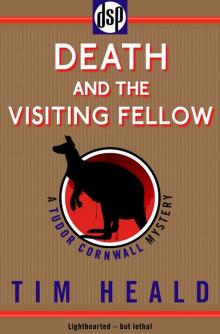 Death and the Visiting Fellow
Death and the Visiting Fellow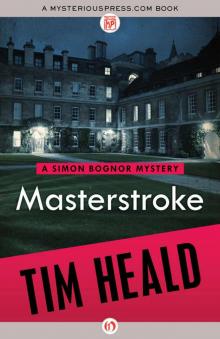 Masterstroke (The Simon Bognor Mysteries)
Masterstroke (The Simon Bognor Mysteries) Deadline (The Simon Bognor Mysteries)
Deadline (The Simon Bognor Mysteries)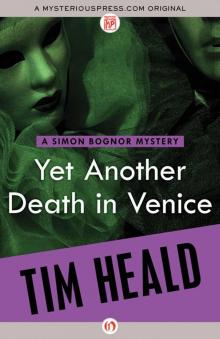 Yet Another Death in Venice (The Simon Bognor Mysteries)
Yet Another Death in Venice (The Simon Bognor Mysteries) Just Desserts (The Simon Bognor Mysteries)
Just Desserts (The Simon Bognor Mysteries)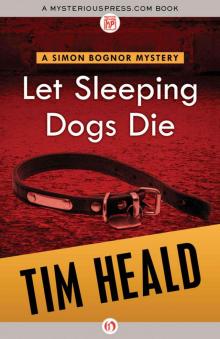 Let Sleeping Dogs Die (The Simon Bognor Mysteries)
Let Sleeping Dogs Die (The Simon Bognor Mysteries)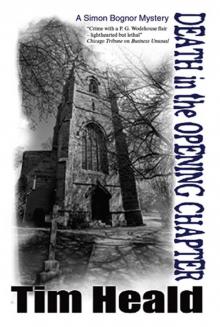 Death in the Opening Chapter
Death in the Opening Chapter Blue Blood Will Out (The Simon Bognor Mysteries)
Blue Blood Will Out (The Simon Bognor Mysteries)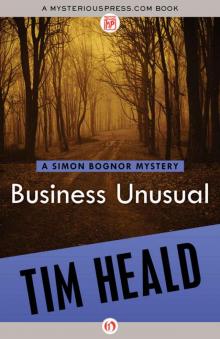 Business Unusual (The Simon Bognor Mysteries)
Business Unusual (The Simon Bognor Mysteries)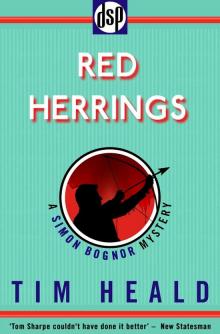 Red Herrings
Red Herrings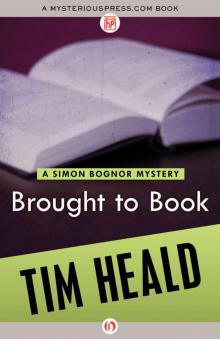 Brought to Book (The Simon Bognor Mysteries)
Brought to Book (The Simon Bognor Mysteries)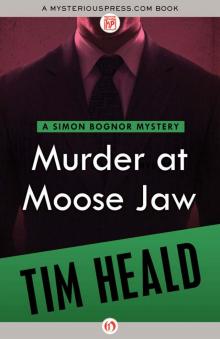 Murder at Moose Jaw (The Simon Bognor Mysteries)
Murder at Moose Jaw (The Simon Bognor Mysteries)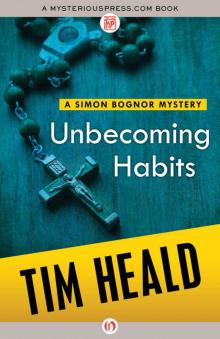 Unbecoming Habits (The Simon Bognor Mysteries Book 1)
Unbecoming Habits (The Simon Bognor Mysteries Book 1)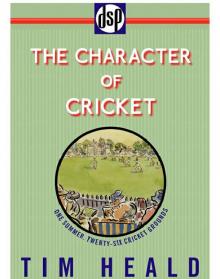 The Character of Cricket
The Character of Cricket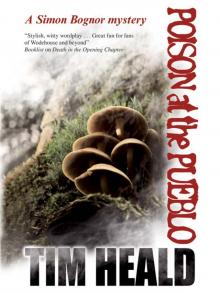 Poison At The Pueblo
Poison At The Pueblo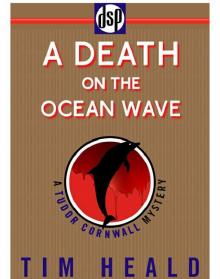 A Death on the Ocean Wave
A Death on the Ocean Wave